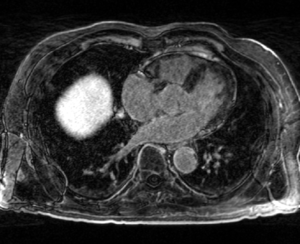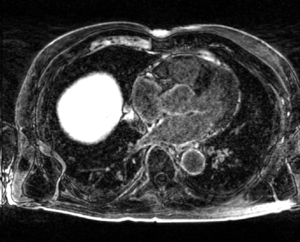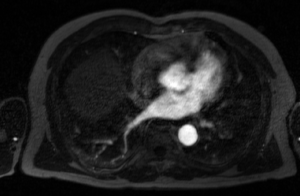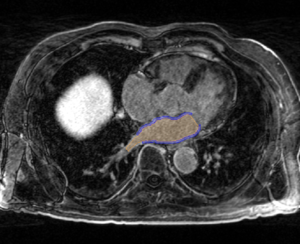Difference between revisions of "DBP3:Utah:Reg Motiv"
From NAMIC Wiki
| Line 1: | Line 1: | ||
= Left Atrial Registration = | = Left Atrial Registration = | ||
| − | * | + | * The CARMA Center uses contrast-enhanced MRI images to evaluate new patients, predict procedural success, and evaluate therapeutic outcomes. The MRI images for each patient are further accompanied by MR angiographic images (MRA) and manual segmentations of relevant structures. These images are acquired longitudinally over the course of a patient's evaluation, treatment, and follow-up (i.e. months or years). Registration is often necessary to compare images from different time points in a patient's treatment, or even across patient cohorts at the same stage of disease progression or treatment. |
{| class="wikitable" | {| class="wikitable" | ||
| Line 20: | Line 20: | ||
|- | |- | ||
| The MRA is acquired after contrast injection and before the LGE-MRI images above. This image type highlights the blood pool of the LA and some surrounding structures. | | The MRA is acquired after contrast injection and before the LGE-MRI images above. This image type highlights the blood pool of the LA and some surrounding structures. | ||
| − | | | + | | Manual segmentation of the LA is performed on pre- and post-ablation LGE-MRI images by the CARMA team. Here the blue mask denotes the LA wall and the orange the blood pool. |
|- | |- | ||
|} | |} | ||
| + | |||
| + | = Pulmonary Vein Anatomy = | ||
| + | * The pulmonary veins (PVs) are important in the initiation and sustainment of AF, often harboring the electrical triggers responsible for AF. In an effort to remove or isolate these extraneous electrical signals, the PVs are often the target of ablation procedures; this often induces changes in the gross-anatomical structure of the PVs. The changes in PVs shape and structure caused by ablation make registration of the PVs non-trivial. | ||
| + | |||
| + | * The number of PVs across patients also differs; the typical configuration consists of 4 PVs: an inferior and superior vein on both the right and left sides of the LA. The most common deviations from this model are: a common left PV trunk, 3 right-side PVs, and 4 right-side PVs. Deviations in the number of PVs affects the landmarks used for image registration. | ||
| + | |||
| + | * Registration of the PVs has been approached using image-regsitration techniques rather than surface-registration techniques; the surfaces below are used because they show the variations in PV anatomy in a more clear and concise manner than the corresponding images. | ||
| + | |||
| + | {| class="wikitable" | ||
| + | |- | ||
| + | ! Common Left PV Ostium | ||
| + | ! 3 Right PVs | ||
| + | |- | ||
| + | | [[File:carma_ex_pre.png|thumb|center]] | ||
| + | | [[File:carma_ex_post.png|thumb|center]] | ||
| + | |- | ||
| + | | M | ||
| + | | M | ||
| + | |- | ||
| + | ! 4 Right PVs | ||
| + | ! Small and Large RPV | ||
| + | |- | ||
| + | | [[File:carma_ex_mra.png|thumb|center]] | ||
| + | | [[File:carma_ex_pre_seg.png|thumb|center]] | ||
| + | |- | ||
| + | | T | ||
| + | | M | ||
| + | |- | ||
| + | |} | ||
| + | |||
| + | = Conclusion = | ||
| + | * In conclusion, registration of the LA is plagued by changes in various anatomical structures as the disease progresses and from one patient to the next. | ||
| + | * LA registration is further complicated by the thin LA walls and motion of the beating heart. | ||
Revision as of 23:34, 6 January 2012
Home < DBP3:Utah:Reg MotivLeft Atrial Registration
- The CARMA Center uses contrast-enhanced MRI images to evaluate new patients, predict procedural success, and evaluate therapeutic outcomes. The MRI images for each patient are further accompanied by MR angiographic images (MRA) and manual segmentations of relevant structures. These images are acquired longitudinally over the course of a patient's evaluation, treatment, and follow-up (i.e. months or years). Registration is often necessary to compare images from different time points in a patient's treatment, or even across patient cohorts at the same stage of disease progression or treatment.
| Pre-ablation LGE-MRI Image | Post-ablation LGE-MRI Image |
|---|---|
| MRI image acquired approx. 15 minutes after contrast injection and prior to ablation. (The LA is the gray, horizontally oriented structure above the spine in the center of the image) | MRI image acquired approx. 15 minutes after contrast injection and after the ablation was performed. Sections of the LA wall which were ablated appear as hyper-enhanced pixels in the LA wall. |
| MRA Image | Segmentation of LGE-MRI Image |
| The MRA is acquired after contrast injection and before the LGE-MRI images above. This image type highlights the blood pool of the LA and some surrounding structures. | Manual segmentation of the LA is performed on pre- and post-ablation LGE-MRI images by the CARMA team. Here the blue mask denotes the LA wall and the orange the blood pool. |
Pulmonary Vein Anatomy
- The pulmonary veins (PVs) are important in the initiation and sustainment of AF, often harboring the electrical triggers responsible for AF. In an effort to remove or isolate these extraneous electrical signals, the PVs are often the target of ablation procedures; this often induces changes in the gross-anatomical structure of the PVs. The changes in PVs shape and structure caused by ablation make registration of the PVs non-trivial.
- The number of PVs across patients also differs; the typical configuration consists of 4 PVs: an inferior and superior vein on both the right and left sides of the LA. The most common deviations from this model are: a common left PV trunk, 3 right-side PVs, and 4 right-side PVs. Deviations in the number of PVs affects the landmarks used for image registration.
- Registration of the PVs has been approached using image-regsitration techniques rather than surface-registration techniques; the surfaces below are used because they show the variations in PV anatomy in a more clear and concise manner than the corresponding images.
| Common Left PV Ostium | 3 Right PVs |
|---|---|
| M | M |
| 4 Right PVs | Small and Large RPV |
| T | M |
Conclusion
- In conclusion, registration of the LA is plagued by changes in various anatomical structures as the disease progresses and from one patient to the next.
- LA registration is further complicated by the thin LA walls and motion of the beating heart.



